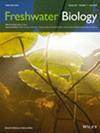Enter the Mosaic: Aquatic-Terrestrial Reciprocal Fluxes and Food Webs Are Dynamically Interdependent Across Space and Through Time
IF 2.7
2区 生物学
Q2 ECOLOGY
引用次数: 0
Abstract
- Decades-old research describes dynamic interdependence among aquatic and terrestrial food webs, leading to calls for integrating cross-ecosystem linkages with landscape ecology to evaluate dynamics of spatially-subsidised food webs. Though development of meta-community theory has suggested that such spatial dynamics may help sustain biodiversity, empirical data remain limited. In northern Yellowstone National Park, over a century of terrestrial wildlife dynamics, including the extirpation and subsequent reintroduction of wolves, have contributed to a habitat mosaic in which stream-riparian ecosystems are dominated by either woody or herbaceous vegetation. In the context of this habitat mosaic, we addressed the overarching questions: (1) Are habitat mosaics associated with spatial and temporal variation in reciprocal fluxes and linked food webs and (2) how do biodiversity, organism traits and species interactions influence, and are they influenced by, that spatial and temporal variation?
- From 2019 to 2021, we intensively sampled eight headwater streams to characterise reciprocal fluxes of aquatic and terrestrial invertebrates and the patterns of potential responses by fish, birds, bats and spiders. We evaluated sites individually as well as how they contributed to a meta-community.
- We found that local stream-riparian ecosystems contributed to a mosaic in which reciprocal fluxes of invertebrates among local patches were asynchronous and tracked by both aquatic and terrestrial consumers in ways mediated by organism traits. Within sites, aquatic and terrestrial invertebrate fluxes were seasonally asynchronous with each other, but these patterns varied from site to site. Across the mosaic, comparisons of daily aquatic insect emergence varied from 25% to 167% among streams and did so variably throughout the year, revealing asynchronous dynamics created at the meta-community scale. Daily inputs of terrestrial invertebrates were similarly asynchronous across the mosaic, varying from 14% to 170%. These asynchronies were positively correlated with invertebrate beta diversity and associated with varying riparian vegetation, stream temperature, and flow regimes. In turn, in situ consumers tracked the allochthonous invertebrate prey in ways that were mediated by site context (i.e., local habitat characteristics) and consumer traits (e.g., range, foraging strategy and breeding requirements).
- Based on these observations as an example, we infer there is not one way for food webs to be reciprocally and spatially linked, but multiple ways that can vary both across a spatial mosaic and through time. Our findings provide empirical evidence suggesting potential relationships between habitat complexity and the maintenance of biodiversity via aquatic-terrestrial reciprocal fluxes and dynamic interdependence across mosaics.
进入马赛克:水陆相互作用的通量和食物网在空间和时间上是动态相互依赖的
几十年前的研究描述了水生和陆地食物网之间的动态相互依存关系,从而呼吁将跨生态系统联系与景观生态学结合起来,以评估空间补贴食物网的动态。虽然元群落理论的发展表明这种空间动态可能有助于维持生物多样性,但经验数据仍然有限。在黄石国家公园北部,一个多世纪以来陆地野生动物的动态变化,包括狼的灭绝和随后的重新引入,促成了一个栖息地马赛克,其中河流-河岸生态系统由木本或草本植被主导。在这种生境马赛克的背景下,我们解决了一些首要问题:(1)生境马赛克是否与相互通量和相互联系的食物网的时空变化有关;(2)生物多样性、生物性状和物种相互作用如何影响这种时空变化,以及它们是否受到这种时空变化的影响?从2019年到2021年,我们对8条源头溪流进行了密集采样,以表征水生和陆生无脊椎动物的相互通量,以及鱼类、鸟类、蝙蝠和蜘蛛的潜在响应模式。我们单独评估了站点以及它们对元社区的贡献。我们发现,当地的河流-河岸生态系统促成了一个马赛克,在这个马赛克中,无脊椎动物在当地斑块之间的相互通量是异步的,并且通过生物特征介导的方式被水生和陆地消费者跟踪。在站点内,水生和陆生无脊椎动物的通量在季节上彼此不同步,但这些模式因站点而异。在整个马赛克中,河流中水生昆虫的日出苗率从25%到167%不等,并且全年变化不定,揭示了在元群落尺度上产生的异步动态。陆地无脊椎动物的日常输入在整个马赛克中也同样是异步的,从14%到170%不等。这些不同步与无脊椎动物多样性呈正相关,并与不同的河岸植被、河流温度和流量状况相关。反过来,原位消费者以现场环境(即当地栖息地特征)和消费者特征(如范围、觅食策略和繁殖要求)为媒介的方式追踪外来无脊椎动物猎物。以这些观察结果为例,我们推断食物网在空间上相互联系的方式不是一种,而是多种方式,可以在空间马赛克和时间上发生变化。我们的研究结果提供了经验证据,表明栖息地复杂性与生物多样性维持之间的潜在关系是通过水陆互反通量和马赛克之间的动态相互依赖来实现的。
本文章由计算机程序翻译,如有差异,请以英文原文为准。
求助全文
约1分钟内获得全文
求助全文
来源期刊

Freshwater Biology
生物-海洋与淡水生物学
CiteScore
5.90
自引率
3.70%
发文量
162
审稿时长
2 months
期刊介绍:
Freshwater Biology publishes papers on all aspects of the ecology of inland waters, including rivers and lakes, ground waters, flood plains and other freshwater wetlands. We include studies of micro-organisms, algae, macrophytes, invertebrates, fish and other vertebrates, as well as those concerning whole systems and related physical and chemical aspects of the environment, provided that they have clear biological relevance.
Studies may focus at any level in the ecological hierarchy from physiological ecology and animal behaviour, through population dynamics and evolutionary genetics, to community interactions, biogeography and ecosystem functioning. They may also be at any scale: from microhabitat to landscape, and continental to global. Preference is given to research, whether meta-analytical, experimental, theoretical or descriptive, highlighting causal (ecological) mechanisms from which clearly stated hypotheses are derived. Manuscripts with an experimental or conceptual flavour are particularly welcome, as are those or which integrate laboratory and field work, and studies from less well researched areas of the world. Priority is given to submissions that are likely to interest a wide range of readers.
We encourage submission of papers well grounded in ecological theory that deal with issues related to the conservation and management of inland waters. Papers interpreting fundamental research in a way that makes clear its applied, strategic or socio-economic relevance are also welcome.
Review articles (FRESHWATER BIOLOGY REVIEWS) and discussion papers (OPINION) are also invited: these enable authors to publish high-quality material outside the constraints of standard research papers.
 求助内容:
求助内容: 应助结果提醒方式:
应助结果提醒方式:


